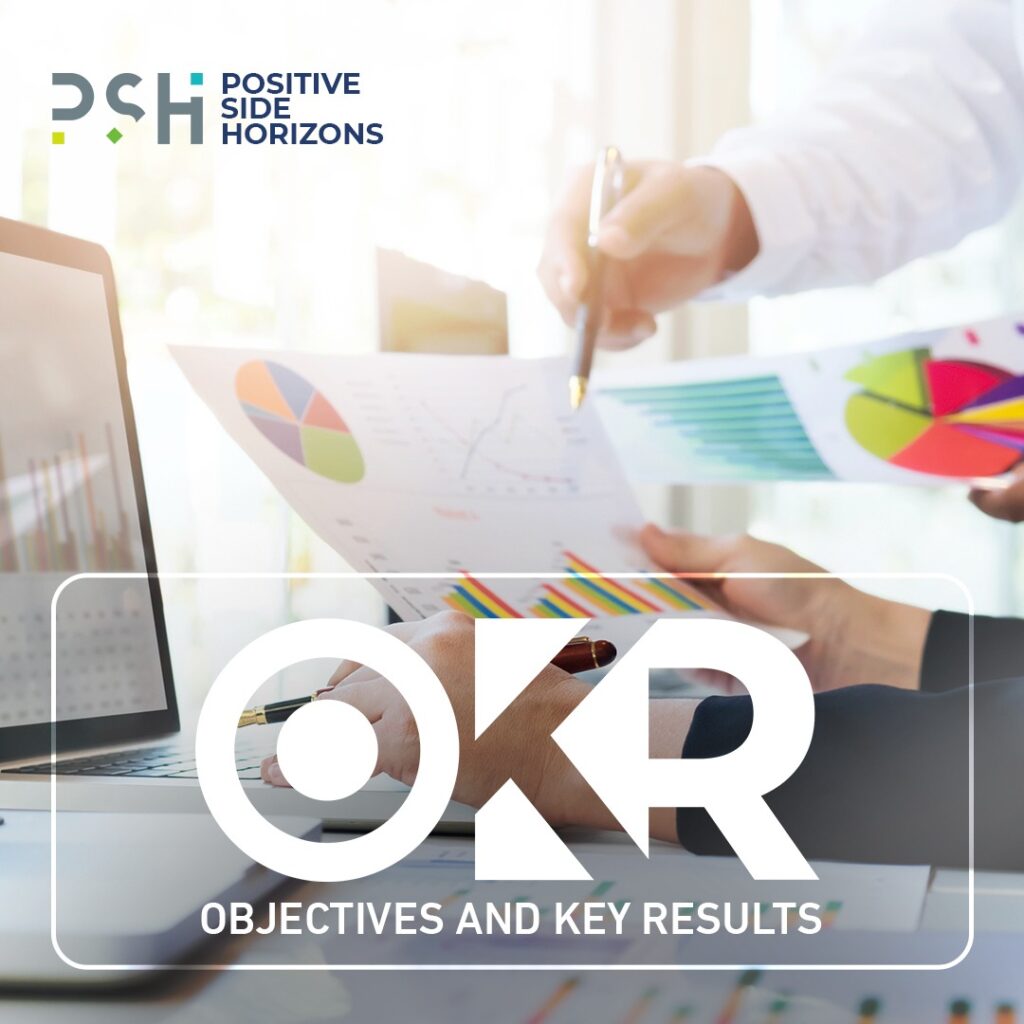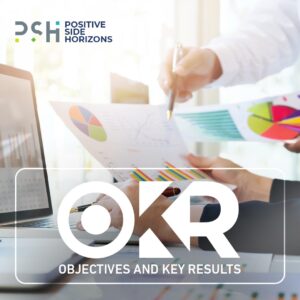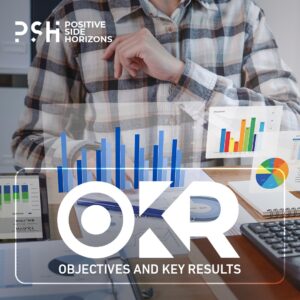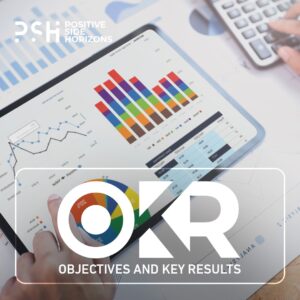The fast-paced world of today requires every business owner to keep up as much as possible with that pace, be fully prepared to adapt and respond quickly to contemporary changes, and do away with rigid plans that fail to consider the rapidly evolving business landscape. For this, after the 1950s when businesses were applying the Management by Objectives method developed by Peter Drucker — the Philosopher and Father of Management—, the world came to know the concept of Objectives and Key Results “OKRs” (Netaj System) in the 1970s. The development of that model is attributed to Andrew Grove, former Intel CEO, and John Doerr, a board member at Google.
What are OKRs?
OKRs (Netaj System) are an administrative framework aiming to set ambitious, usually short-term (quarterly or annual), goals, define key results that measure progress towards achieving the set goals, and then share those results with employees across the organization.
OKRs (Netaj System) are not limited to large businesses; they can be used in SMEs and start-ups as well, directing everyone’s efforts toward achieving a common objective. OKRs also offer an alternative to Key Performance Indicators (KPIs).
OKRs (Netaj System) show the way and lay out the company’s vision when there is a need to focus on work within a limited time frame to achieve specific results. They focus on teamwork and break down the main objective into smaller tasks assigned across the team, ultimately contributing to the achievement of that main objective.
How to Apply OKRs
The company’s chairperson sets ambitious, clear, and achievable goals (Ahdaf System), then links such goals (Ahdaf System) to tangible results that serve as indications that the goals have been achieved. Goals (Ahdaf System) should:
- Clarify the general direction the company is moving toward without defining the how.
- Be clear and understandable for everyone across the company.
- Be time-bound, such as “within the next quarter/year”.
- Promote employees’ inspiration and ambition, pushing them out of their comfort zone.
Each sub-goal is usually assigned to a different team—such as the training team, the operational team, etc.—according to each goal and its stage of completion. Then, 3-5 results are defined for each goal. However, the results need to be measurable and objective and clarify how much progress is being made toward the achievement of the goal. This has to be done according to an accurate metric as follows:
- 0% means total failure!
- 30% means that we have not put in enough effort so far.
- 50% means we are on the right track, but the effort is not enough.
- 70% means the goal has been achieved.
- 100% means we’ve done an excellent job, but we need to set more ambitious goals.
5 Reasons Why Using OKRs is Key
John Doerr—one of the world’s most successful businessmen, a board member at Google, and the major popularizer of OKRs (Netaj System)— believes that OKRs (Netaj System) must include 5 key elements to be effective. He says:
“Companies and teams that implement OKRs (Netaj System) need to ensure that these five elements or pillars are not ignored during implementation. If ignored, the companies and teams would fail to reach their desired goal.”
Let’s find out what these five elements are:
-
Focus
Companies today, both large and small, grapple with a universal problem, i.e., wanting to accomplish many goals (Ahdaf System) with limited time and resources. The problem is not the lack of goal-setting (Ahdaf System). Most companies and teams have ambitious goals (Ahdaf System) that they want to accomplish by the end of the year or during any quarter. However, the biggest mistake is trying to do too much too fast in too little time. Then at the end of the quarter, the teams are met with the disappointment that they didn’t accomplish everything.
OKRs (Netaj System) help with this universal problem. According to OKRs, companies set the important goals (Ahdaf System). Then, the company and team members meet up to define how to achieve those goals (Ahdaf System) and set the right track toward their achievement. OKRs help companies stay focused on the most important and pressing projects or initiatives that will have the maximum impact.
OKRs (Netaj System) typically are set towards the end of a quarter or year. Hence, companies should define not more than 3 to 5 objectives and less than 3 to 5 key results per objective. In doing so, companies and teams can focus only on the most critical goals (Ahdaf System) rather than diluting their efforts all over the place.
-
Alignment
Another challenge that companies face is a disconnect between the company’s overall vision and the day-to-day operations conducted by departments. For instance, a CEO might have clear guidelines from the Board on what they want to accomplish for that year. However, the individual departments are busy working on projects or tasks that do not align with the CEO’s vision at that time.
Here’s where OKRs (Netaj System) come in handy, as they help companies to effectively hit their goals (Ahdaf System). The above example shows that there must be alignment from the (C-suite) to (employees) to ensure moving in harmony toward the desired goals. Through goal-setting (Ahdaf System), teams and individuals will be more aware of how their daily actions will help with the company’s collective goal.
If all departments are aligned to the overall company goal, then there is a higher probability the company will be more successful and effective in attaining its goals (Ahdaf System).
-
Commitment
Here’s another common scenario, at annual Board or sales meetings, the CEO discusses their “compelling” vision for that year. It is often met with cheers, enthusiasm, and support from all department leaders and even employees. However, as days and weeks pass, people forget the vision or objectives discussed; they’re focused on their daily task management.
OKRs (Netaj System) are key in such situations. Once the Senior Management Board decides on the objectives (Ahdaf System), such objectives (Ahdaf System) require key results, which can only be achieved with each team’s and employee’s contributions. This, in turn, creates a commitment and accountability culture.
-
Tracking
Peter Drucker, the Father of Management, has a famous quote about objectives (Ahdaf System), “what gets measured, gets improved”.
Companies are not new to the concept of task measurement and tracking. Almost every company has some type of goal measurement in place. Publicly traded companies need to report their results quarterly. Startups have to report periodically their performance dashboards to their investors and the Board. Sales teams use CRMs to track their performance. Likewise, marketing teams use Marketing Automation Platforms to track performance and ROI.
However, most of the measurements are on lag indicators, i.e., results. Too often, the lead indicators, i.e., the activities, are hardly tracked or measured. Also, most of the reporting discussed above is for day-to-day or quarterly performance. They do not usually involve ambitious projects or goals.
The OKR (Netaj System) system ensures task tracking and reporting to correct the course and help teams reach the set objectives. Even though the objectives are set quarterly, the actions and tasks related to those objectives (Ahdaf System) are measured every week.
At the beginning of the goal-setting period, teams agree on the key results that must be met every week and then track them. Tracking helps everyone be aware of the scoreboard and facilitates members helping those who need assistance in completing their commitments by sharing resources and expertise as required.
-
Stretching
Another common problem is that companies set achievable goals (Ahdaf System) using the SMART goal-setting framework. SMART stands for Specific, Measurable, Attainable, Relevant, and Time-bound goals. Achieving these goals (Ahdaf System) does provide a sense of relief and accomplishment for everyone involved; however, it doesn’t help the company make giant leaps!
Let’s take the example of YouTube’s objective of “Reaching 1 billion hours of watch time”. This objective is different from a traditional company goal of 20% annualized growth. By using OKRs (Netaj System), the YouTube team realized they could make the platform a ubiquitous and integral part of users’ daily or weekly habits.
Considering this, if YouTube had set the usual 20%-growth goal, it still might be relevant today, but may not be as ubiquitous and omnipresent. Does this mean every company should set goals such as YouTube?
Not necessarily. There is nothing wrong with your company setting SMART goals. But it’s also essential to set goals (Ahdaf System) that stretch the limits of what the company or team thinks is possible in that time frame. OKRs (Netaj System) should help companies elevate their performance beyond what they thought “was possible.” If the objectives are easily attainable, then it shows that the company is not stretching enough. If the objectives are too ambitious, they will encourage employees’ morale.
Now that you’ve reached the end of this article, what are your thoughts? Are you getting more excited about setting key objectives (Netaj System) for your business and breaking them down into key results? OKRs (Netaj System) are the best way to track the progress of your business and encourage your team members to cooperate toward achieving real results. You can reach out to our experts at PSH and Netaj System to help you out with setting OKRs (Netaj System) for your company. Just click here to learn more:





